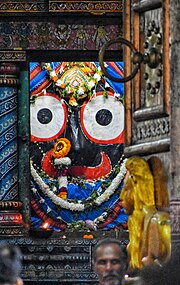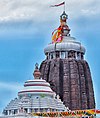Chinta Kamodi
| Odia script | ଚିନ୍ତା କାମୋଦୀ |
|---|---|
| Melā | Sri |
| Jati | Oudaba - Bakra Sampurna |
| Badi | Rusabha |
| Sambadi | Panchama |
| Allied Ragas | Rasa Kamodi |
Chinta Kamodi (Odia: ଚିନ୍ତା କାମୋଦୀ, romanized: chintā kāmodi) is a rāga belonging to the tradition of Odissi music.[1][2][3] Falling under the meḷa Sri,[4] the raga uses both suddha nisada and komala nisada swaras and is traditionally associated with the bhakti rasa.[5] Occasionally, the komala gandhara is employed in a bakra prayoga.
Structure[edit]
An ancient raga, Chinta Kamodi is accepted as one of the primary melas in Odissi music due to its prominence. It has been used by hundreds of poet-composers for well-over the past many centuries.[6] Its bakra or devious aroha-abaroha are given below:
Aroha: S R M P D S
Abaroha: S N D n D P M G R S
| Oṛiśī Sangīta |
| Odissi music |
|---|
 |
| Composers |
| Shāstras |
| Compositions |
| Instruments |
Compositions[edit]
Some of the well-known traditional compositions in this raga include:
- Ahe Nila Saila by Salabega
- Mana Uddharana Kara He Karana by Upendra Bhanja
References[edit]
- ^ Panda, Pt. Gopal Chandra (2004). Odisi Raga Ratnabali ओडिसी राग रत्नावली (in Hindi). Bhubaneswar. OCLC 225908458.
{{cite book}}: CS1 maint: location missing publisher (link) - ^ Parhi, Dr. Kirtan Narayan (2017). The Classicality of Orissi Music. India: Maxcurious Publications Pvt. Ltd. p. 383. ISBN 9788193215128.
- ^ Hota, Dr. Damodar (2012). Udra Paddhatiya Sangita (in Odia). Vol. 2. Bhubaneswar: Swara-Ranga. pp. 18–19.
- ^ Odisi Raga Sarani. Bhubaneswar: Odissi Research Centre. 2004.
- ^ Misra, Purusottama (2009). Bose, Prof. Mandakranta (ed.). Sangitanarayana (A Seventeenth Century Text on Music and Dance from Orissa). Indira Gandhi National Centre for the Arts and Motilal Banarsidass Publishers Pvt. Ltd. ISBN 9788120832886.
- ^ Das, Ramhari (2004). Odissi Sangeetara Parampara O Prayoga ଓଡ଼ିଶୀ ସଙ୍ଗୀତର ପରମ୍ପରା ଓ ପ୍ରୟୋଗ [The tradition and method of Odissi music] (in Odia). Bhubaneswar, Odisha: Kaishikee Prakashani.

